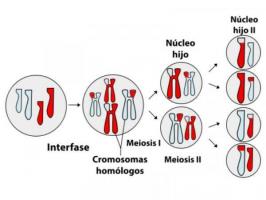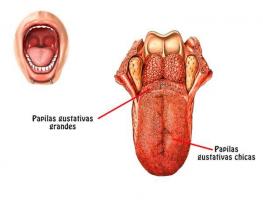COMPLETE classification of arthropods
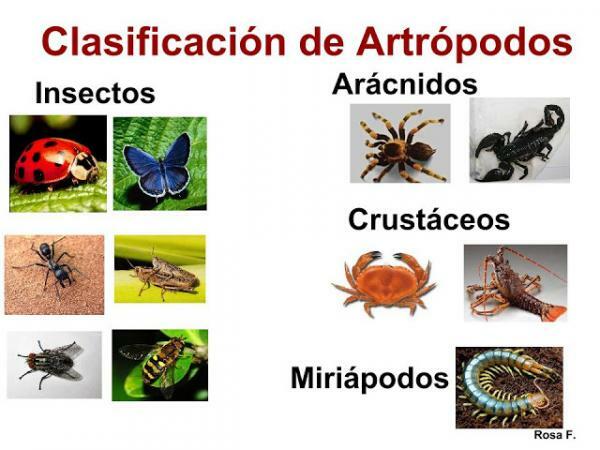
Image: Info Agro
The arthropods They are the most numerous animal phylum on earth, both in number of animals and in number of different species. Arthropods represent more than 80% of known species! In addition, these invertebrates appeared a long time ago and have been able to colonize a large number of different ecosystems from seas and oceans to forests, through rivers or even through cities. From chelicerates, which include spiders or scorpions, to centipedes or millipedes, through crustaceans and insects, in this lesson we will review the five groups of arthropods: chelicerates, myriapods, crustaceans, hexapods, and the extinct trilobitomorphs. If you want to discover the classification of arthropods, Keep reading this lesson!
Index
- Hexapods
- Crustaceans
- The myriapods
- The chelicerates
- Trilobitomorphs
Hexapods.
Within the classification of arthropods we have to speak of the group of hexapods They have six legs (three pairs) and all of them are located on the thorax, the upper part of the body.
The hexapods is the largest group of arthropods since within this are the insects, Of which more than a million species have been described! In addition to insects, within this group we find the proturs, the diplomas and the Collembola which are organisms that closely resemble true insects and feed mostly on spores or remains of fungi and small pieces of organic matter found in the soil.
Within the hexapods we can find animals with land locomotion holding on their legs that allow them to adhere to many surfaces, although sometimes they appear accessory structures as in the case of spiders, whose webs allow them to hang from the most unsuspected. We also found some flying, most of which are insects: flies, dragonflies, bees and wasps, etc. and there are even some who once had wings, but have lost them in their evolution. These are a group of insects called aptera (fleas, lice, and some aphids). Other hexapods are excavators, they can walk on water using surface tension, etc.
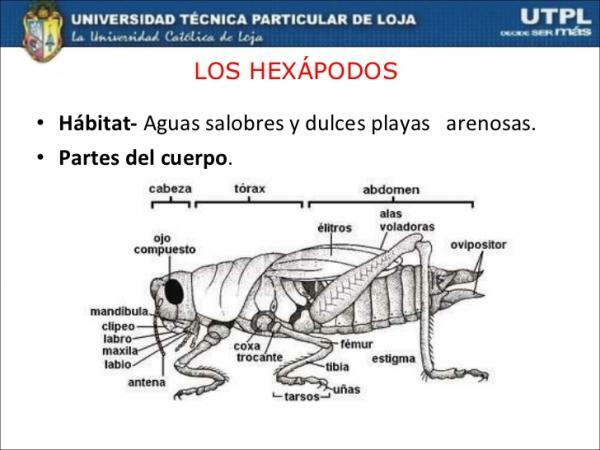
Image: Slideshare
Crustaceans.
The second best known group arthropods are the crustaceans. Just as insects dominate terrestrial life, crustaceans have been able to adapt to all types of environments aquatic from seas and oceans to freshwater rivers and lakes and to wet ecosystems inhabited by moisture mealybugs. These animals are known for their tough and tough shells. As a disadvantage, these shells have to be shed to allow their body to grow in periods of intermute. In addition to this, crustaceans are characterized by having two pairs of before and a special type of larva with one eye, called nautilus.
The crustacean size is highly variable and ranges from the microscopic size of the water lice to the four meters of the Japanese spider crab. Their body shape, appendages, and role in the ecosystem are also highly varied. Remember that within crustaceans we find organisms as different as water fleas, brine shrimp, copepods, barnacles, prawns, galleys, prawns, krill, shrimp or mealybugs humidity. Finding two types of crustaceans the same is almost impossible!
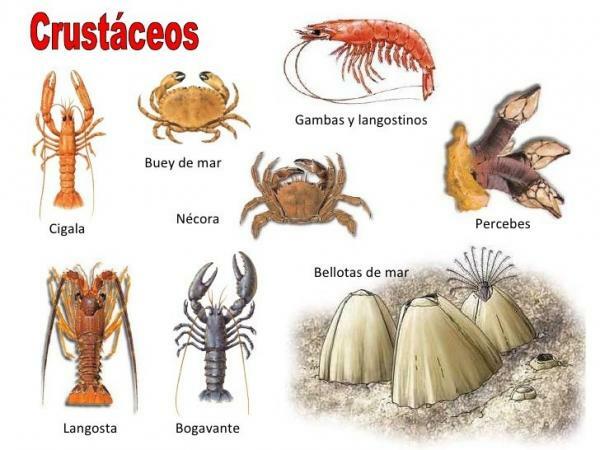
Image: Animals
The myriapods.
Continuing with the classification of arthropods, we will now talk about the myriapods, the group of arthropods that includes the centipedes, millipedes, pauropods, and symphyla.
All myriapods are terrestrial and can be distinguished with the naked eye because their body is made up of only two regions: head and body, which is accompanied by many or even many pairs of legs. Most myriapods have one pair of antennae on the head, two pairs of jaws, and all the legs are concentrated on the body although, in the case of some centipedes and scolopendras, the first pair of legs has been modified to form stingers that inject poison. While some myriapods use their numerous legs to move, others prefer to roll up their body and form a kind of ring that allows them roll to scroll.
These animals have different habits but in general they seek the humidity and the darkness. Some of them feed on plants or leaveseither fresh or decomposing while others feed on animals smaller than themselves and are predators quite voracious.
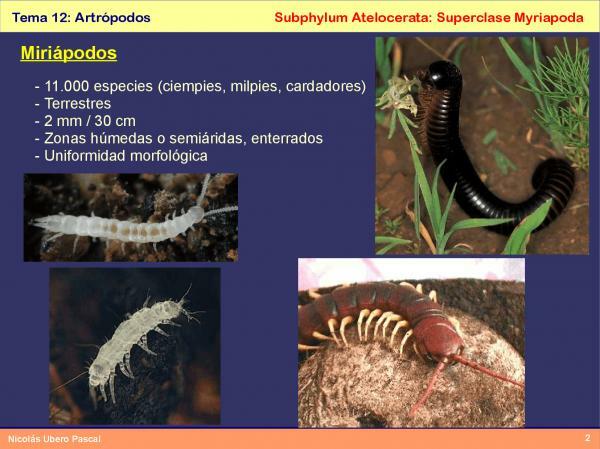
Image: Docsity
The chelicerates.
The chelicerates are a very peculiar group of arthropods characterized by lack antennas and have a special type of jaw, the queliceros. Within the chelicerates, some groups are currently extinct since it is a group that appeared very early in evolution and not all species have survived. The best known and most numerous chelicerates are the arachnids, which currently includes 70,000 species of spiders, scorpions, mites, opilones (spiders with thin legs), vinegar, amblipigia, etc.
The chelicerates have very diverse food and habitats, although most of them they are predators. Merostomes, known as pan crabs, live in the sea and feed on mollusks, annelids and marine invertebrates from small size while arachnids have adapted to life on dry land and feed on small insects and invertebrates.
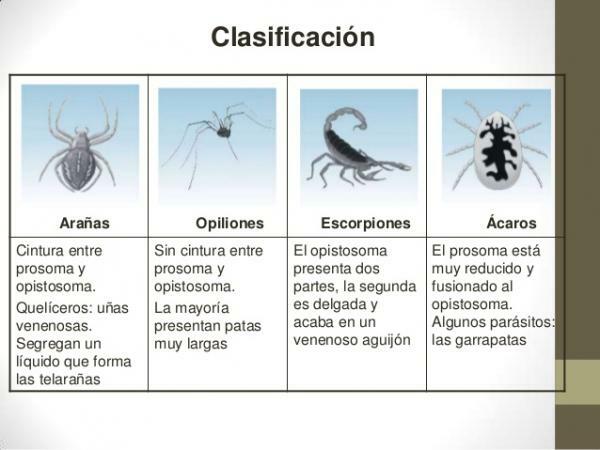
Image: Slideshare
The trilobitomorphs.
The last group within the arthropod classification are the trilobitomorphs, a group of invertebrates is currently Extinct.
The best known trilobitoforms are the trilobites, which give the group its name, but they were not the only ones since this group was made up of more than 4,000 species of animals that lived on Earth during the Paleozoic and the ages that followed.
Because they were very abundant and very numerous, today they are probably the best known animals thanks to fossils and it is even known what their jaws were like! These animals are known to have flattened bodies, lived in the sea and oceans (although not in fresh water), and were probably dedicated to filtering the mud from the seabed in search of food (small particles of organic matter, small insects, etc.).

If you want to read more articles similar to Classification of arthropods, we recommend that you enter our category of biology.
Bibliography
- Zhang, Z. Q. (2013). Phylum arthropoda. Zootaxa, 3703 (1), 17-26.
- Jimeno A. & Blasco A. (August 18, 2016) Kingdom animals (metazoans) II. Arthropods. Recovered from http://www.aula2005.com/html/cn1eso/17invertebratsartropodes/17artropodes2es.htm
- Wikipedia (July 16, 2019). Hexapoda. Recovered from https://es.wikipedia.org/wiki/Hexapoda
- Wikipedia (June 3, 2019). Crustacea. Recovered from https://es.wikipedia.org/wiki/Crustacea
- Wikipedia (July 19, 2019). Myriapoda. Recovered from https://es.wikipedia.org/wiki/Myriapoda
- Wikipedia (July 11, 2019). Chelicerata. Recovered from https://es.wikipedia.org/wiki/Chelicerata
- Wikipedia (August 1, 2019). Trilobite. Recovered from https://es.wikipedia.org/wiki/Trilobita


